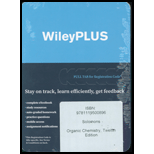
Interpretation:
A synthetic strategy of converting stearic acid to given products is to be devised.
Concept Introduction:
Electrophiles are electron deficient species which has positive or partially positive charge. Lewis acids are electrophiles which accept electron pair.
Nucleophiles are electron rich species which has negative or partially negative charge. Lewis bases are nucleophiles which donate electron pair.
Free radical is an atom, molecule or ion that has unpaired electrons which makes it highly chemically reactive.
Substitution reaction: A reaction in which one of the hydrogen atoms of a hydrocarbon or a
Elimination reaction: A reaction in which two substituent groups are detached and a double bond is formed is called elimination reaction.
Addition reaction: It is the reaction in which unsaturated bonds are converted to saturated molecules by the addition of molecules.
Amides can be reduced to amine using lithium aluminum hydride
Alcohols can be converted to alkyl bromides using phosphorous tribromide (PBr3).
Carboxylic acids can be converted to esters using either Fischer esterification or Steglich esterification. In Fischer esterification, alcohols and carboxylic acids are condensed using catalytic amounts of concentrated sulfuric acid.
Steglich esterification, on the other hand, employs DCC (N,N´-dicyclohexylcarbodiimide) in conjunction with DMAP (4-dimethylaminopyridine) catalyst.
Carboxylic acids can be coupled with secondary amines using coupling agent like
Stearic acid can be first converted to stearoyl chloride, which can subsequently be converted to ethyl stearate using ethyl alcohol.
The stearic acid is converted to ethyl stearate in the presence of tert-butyl alcohol, DCC and DMAP.
Stearic acid can first be converted to stearoyl chloride, which can then be allowed to react with ammonia to form stearamide.
The stearic acid can be coupled with dimethylamine using
The stearic acid is converted to stearamide, and then the stearamide is reduced with LiAlH4 to form octadecyl amine.
The stearic acid can first be converted to stearamide, which can then be converted to heptadecylamine using Hofmann rearrangement.
Octadecanal can be prepared by first reducing stearic acid to 1-octadecanol, and then oxidizing 1-octadecanol with Dess–Martin periodinane.
Octedecyl stearate can be prepared from the condensation of stearic acid and octadecyl alcohol using Fischer esterification.
Stearic acid can be converted to 1-octadecanol by borane reduction.
2-Nonadecanone can be made first by converting stearic acid to stearoyl chloride.
1-Bromooctadecane can be prepared by first converting stearic acid to 1-octadecanol and then reaction of 1-octadecanol with
Want to see the full answer?
Check out a sample textbook solution
Chapter 23 Solutions
ORGANIC CHEMISTRY-WILEYPLUS ACCESS PKG.
- Calculate the ionization energy of He+ and Li²+ ions in their ground states. Thannnxxxxx sirrr Ahehehehehejh27278283-4;*; shebehebbw $+$;$-;$-28283773838 hahhehdvaarrow_forwardPlleeaasseee solllveeee question 3 andd thankss sirr, don't solve it by AI plleeaasseee don't use AIarrow_forwardCalculate the chemical shifts in 13C and 1H NMR for 4-chloropropiophenone ? Write structure and label hydrogens and carbonsarrow_forward
- 4. Read paragraph 4.15 from your textbook, use your calculated lattice energy values for CuO, CuCO3 and Cu(OH)2 an explain thermal decomposition reaction of malachite: Cu2CO3(OH)2 →2CuO + H2O + CO2 (3 points)arrow_forwardPlease sirrr soollveee these parts pleaseeee and thank youuuuuarrow_forwardIII O Organic Chemistry Using wedges and dashes in skeletal structures Draw a skeletal ("line") structure for each of the molecules below. Be sure your structures show the important difference between the molecules. key O O O O O CHON Cl jiii iiiiiiii You can drag the slider to rotate the molecules. Explanation Check Click and drag to start drawing a structure. Q Search X G ©2025 McGraw Hill LLC. All Rights Reserved. Terms of Use F 3 W C 3/5arrow_forward
- 3. Use Kapustinskii's equation and data from Table 4.10 in your textbook to calculate lattice energies of Cu(OH)2 and CuCO3 (4 points)arrow_forward2. Copper (II) oxide crystalizes in monoclinic unit cell (included below; blue spheres 2+ represent Cu²+, red - O²-). Use Kapustinski's equation (4.5) to calculate lattice energy for CuO. You will need some data from Resource section of your textbook (p.901). (4 points) CuOarrow_forwardWhat is the IUPAC name of the following compound? OH (2S, 4R)-4-chloropentan-2-ol O (2R, 4R)-4-chloropentan-2-ol O (2R, 4S)-4-chloropentan-2-ol O(2S, 4S)-4-chloropentan-2-olarrow_forward
 Introduction to General, Organic and BiochemistryChemistryISBN:9781285869759Author:Frederick A. Bettelheim, William H. Brown, Mary K. Campbell, Shawn O. Farrell, Omar TorresPublisher:Cengage Learning
Introduction to General, Organic and BiochemistryChemistryISBN:9781285869759Author:Frederick A. Bettelheim, William H. Brown, Mary K. Campbell, Shawn O. Farrell, Omar TorresPublisher:Cengage Learning
